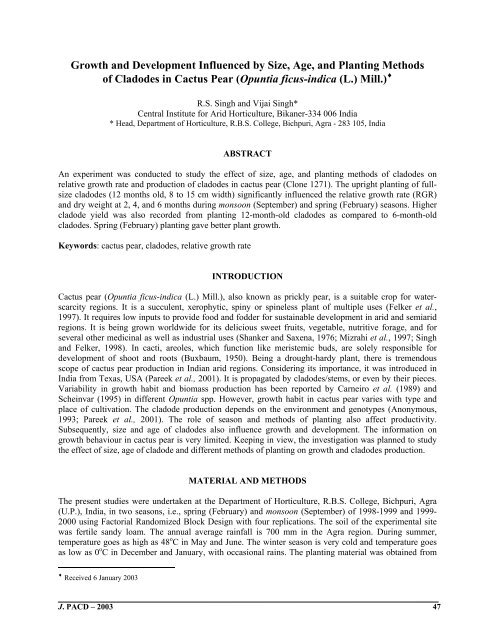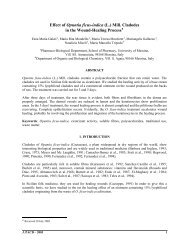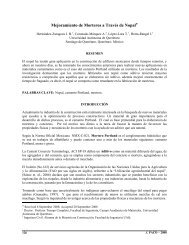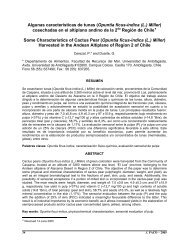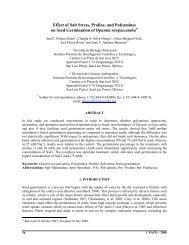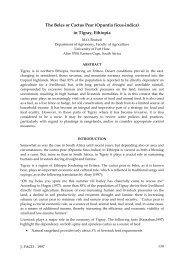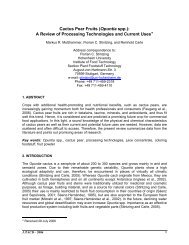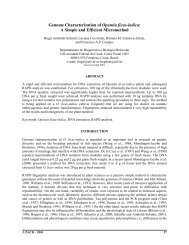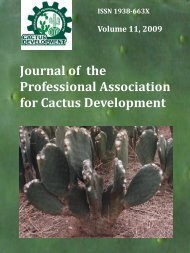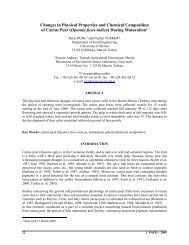Growth and Development Influenced by Size, Age, and Planting ...
Growth and Development Influenced by Size, Age, and Planting ...
Growth and Development Influenced by Size, Age, and Planting ...
You also want an ePaper? Increase the reach of your titles
YUMPU automatically turns print PDFs into web optimized ePapers that Google loves.
<strong>Growth</strong> <strong>and</strong> <strong>Development</strong> <strong>Influenced</strong> <strong>by</strong> <strong>Size</strong>, <strong>Age</strong>, <strong>and</strong> <strong>Planting</strong> Methodsof Cladodes in Cactus Pear (Opuntia ficus-indica (L.) Mill.) ♦R.S. Singh <strong>and</strong> Vijai Singh*Central Institute for Arid Horticulture, Bikaner-334 006 India* Head, Department of Horticulture, R.B.S. College, Bichpuri, Agra - 283 105, IndiaABSTRACTAn experiment was conducted to study the effect of size, age, <strong>and</strong> planting methods of cladodes onrelative growth rate <strong>and</strong> production of cladodes in cactus pear (Clone 1271). The upright planting of fullsizecladodes (12 months old, 8 to 15 cm width) significantly influenced the relative growth rate (RGR)<strong>and</strong> dry weight at 2, 4, <strong>and</strong> 6 months during monsoon (September) <strong>and</strong> spring (February) seasons. Highercladode yield was also recorded from planting 12-month-old cladodes as compared to 6-month-oldcladodes. Spring (February) planting gave better plant growth.Keywords: cactus pear, cladodes, relative growth rateINTRODUCTIONCactus pear (Opuntia ficus-indica (L.) Mill.), also known as prickly pear, is a suitable crop for waterscarcityregions. It is a succulent, xerophytic, spiny or spineless plant of multiple uses (Felker et al.,1997). It requires low inputs to provide food <strong>and</strong> fodder for sustainable development in arid <strong>and</strong> semiaridregions. It is being grown worldwide for its delicious sweet fruits, vegetable, nutritive forage, <strong>and</strong> forseveral other medicinal as well as industrial uses (Shanker <strong>and</strong> Saxena, 1976; Mizrahi et al., 1997; Singh<strong>and</strong> Felker, 1998). In cacti, areoles, which function like meristemic buds, are solely responsible fordevelopment of shoot <strong>and</strong> roots (Buxbaum, 1950). Being a drought-hardy plant, there is tremendousscope of cactus pear production in Indian arid regions. Considering its importance, it was introduced inIndia from Texas, USA (Pareek et al., 2001). It is propagated <strong>by</strong> cladodes/stems, or even <strong>by</strong> their pieces.Variability in growth habit <strong>and</strong> biomass production has been reported <strong>by</strong> Carneiro et al. (1989) <strong>and</strong>Scheinvar (1995) in different Opuntia spp. However, growth habit in cactus pear varies with type <strong>and</strong>place of cultivation. The cladode production depends on the environment <strong>and</strong> genotypes (Anonymous,1993; Pareek et al., 2001). The role of season <strong>and</strong> methods of planting also affect productivity.Subsequently, size <strong>and</strong> age of cladodes also influence growth <strong>and</strong> development. The information ongrowth behaviour in cactus pear is very limited. Keeping in view, the investigation was planned to studythe effect of size, age of cladode <strong>and</strong> different methods of planting on growth <strong>and</strong> cladodes production.MATERIAL AND METHODSThe present studies were undertaken at the Department of Horticulture, R.B.S. College, Bichpuri, Agra(U.P.), India, in two seasons, i.e., spring (February) <strong>and</strong> monsoon (September) of 1998-1999 <strong>and</strong> 1999-2000 using Factorial R<strong>and</strong>omized Block Design with four replications. The soil of the experimental sitewas fertile s<strong>and</strong>y loam. The annual average rainfall is 700 mm in the Agra region. During summer,temperature goes as high as 48 o C in May <strong>and</strong> June. The winter season is very cold <strong>and</strong> temperature goesas low as 0 o C in December <strong>and</strong> January, with occasional rains. The planting material was obtained from♦ Received 6 January 2003J. PACD – 2003 47
Central Soil Salinity Research Institute, Karnal, <strong>and</strong> Central Institute for Arid Horticulture, Bikaner,India. For the study, cactus-pear clone Texas A&M University-Kingsville accession 1271, originallyprovided <strong>by</strong> Dr. Severino Gonzaga Albuquerque in Petrolina, Brazil, where this forage variety was known asPalma giganta, was used which produces abundant fruits at a young age. The cladodes of this strain arespineless, vigorous, erect, <strong>and</strong> fast growing. The height of plants is 1.5 to 2.5 m. Production of fruit starts3 to 4 years after planting on 1- to 2-year-old cladodes. Fruits are large in size (average weight of 150 g).The flesh is light yellow in colour, sweet in taste (TSS 14.0 o Brix). According to age, the cladodes wereseparated into two groups: 6 months old <strong>and</strong> 12 months old. In each age group, they were furthersubdivided <strong>by</strong> size of cladodes into 10- to 15-cm, 10- to 12-cm, <strong>and</strong> 8- to 10-cm widths (all wholecladodes) <strong>and</strong> into 6- to 8-cm, 4- to 6-cm <strong>and</strong> 2- to 4-cm widths of cut pieces. All these cladodes wereplanted <strong>by</strong> five methods: upright, flat, at a 30-degree angle in flat beds, upright planting on ridges, <strong>and</strong> ata 30-degree angle on ridges at 100-cm x 50-cm spacing. For ridge planting, 15- to 20-cm-high ridgeswere prepared. Five cladodes or pieces as per treatment, excluding border plants, were planted. Theorientation of cladode at planting was kept in east-west direction. The common cultural operations such asirrigation, hoeing, weeding, plant protection, etc., were followed during the study. Fresh <strong>and</strong> dry weightsof cladodes in each treatment were recorded before planting in each season. The cladodes were dipped inBavistin (Carbendazim) solution (0.2%) for 5 minutes at the time of planting to check disease infection.The relative growth rate (RGR) of plants was measured at intervals of 2, 4, <strong>and</strong> 6 months after plantingduring both the seasons. One plant from each replication per treatment at every stage was uprootedcarefully <strong>and</strong> washed with water to record observations. Fresh <strong>and</strong> dry (oven dry) weights of plants wererecorded <strong>and</strong> RGR in milligrams per month was calculated <strong>by</strong> using the formula described <strong>by</strong> Noggle <strong>and</strong>Fritz (1986).RGR =2.303 (log 10 W 2 – log 10 W 1 )t 2 – t 1Where W 2 <strong>and</strong> W 1 are the dry weights of the plant at final (t 2 ) <strong>and</strong> initial (t 1 ) times, respectively.The relative growth rate was calculated on the basis of increase in dry weight at successive stages ofgrowth in milligrams per month. The number of cladodes per plant <strong>and</strong> dry weight (in grams) of plantswere recorded 6 months after planting during both the seasons. The pooled data were subjected tostatistical analysis.RESULTS AND DISCUSSIONRelative <strong>Growth</strong> RateThe RGR in cactus pear was calculated on the basis of increase in dry weight at intervals of 2, 4, <strong>and</strong> 6months after planting. The final-stage data on Relative <strong>Growth</strong> Rate values are presented in Table 1. Thedata revealed that size, age, <strong>and</strong> planting methods of cladodes significantly affected RGR values duringboth the seasons. <strong>Planting</strong>s of 12-month-old cladodes exhibited significantly higher relative growth ratesthan the plantings of 6-month-old cladodes in both the seasons. The higher relative growth rate obtainedin 1-year-old planted cladodes possibly may be due to its appropriate age <strong>and</strong> a larger number of activeareoles having more accumulated food material at planting time, which was further utilized for root <strong>and</strong>shoot growth after planting. The results agree with those of Nobel (1988) <strong>and</strong> Mizrahi et al. (1997). Themaximum relative growth rate was observed in upright, at 30-degree-angle planting in flat beds, <strong>and</strong>upright planting on ridges compared to other methods of planting. However, variations in RGR valuesdue to different planting methods (upright, planting at a 30-degree angle in flat beds, as well as plantingon ridges) were statistically similar during both the seasons of planting. The values of RGR at 2, 4, <strong>and</strong> 6months after planting in upright, at a 30-degree angle in flat beds, as well as on ridges, might be due to48 J. PACD – 2003
interception of more light (photoperiod) <strong>and</strong> temperature in these methods of planting, which, in turn,influenced the relative growth rate. Similar results also have been reported <strong>by</strong> Nobel (1988) <strong>and</strong> Mora <strong>and</strong>Palmela (1996). Cladodes of all the sizes differed significantly among themselves with respect to relativegrowth rate. It is noteworthy that the RGR values (in milligrams per month) recorded during the springseason were remarkably higher than those of the monsoon (September) season. It possibly may be due tovigorous growth in the warmer season. The treatment combinations between size, age, <strong>and</strong> plantingmethods of cladodes also influenced the relative growth rate significantly during both the seasons after 6months of growth.With the decrease in width of planted cladodes from 10-15 cm to 2-4 cm, there was a noticeable decreasein RGR values during both the seasons. The higher RGR value, in terms of dry weight increase incladodes obtained <strong>by</strong> planting a full size cladode of 10-15 cm width followed <strong>by</strong> 10-12 cm <strong>and</strong> 8-10 cm,was probably be due to vigorous root <strong>and</strong> shoot growth. Further, it also might be due to accumulation ofrelatively more photosynthates. Similar results have been reported <strong>by</strong> Anonymous (1993) while workingon evaluation of cactus pear genotypes under semiarid conditions of Phaltan, Maharashtra, India.A similar pattern of effect of size of cladodes on RGR was also recorded at 2 <strong>and</strong> 4 months after planting.The variation in RGR values at 2, 4, <strong>and</strong> 6 months revealed that faster growth of the plants occurredbetween 2- to 4-month intervals. Luo <strong>and</strong> Nobel (1993) found that the growth rate in cacti (Opuntia sp.)increased rapidly within the first 30 days after planting; afterward, the increase was more or less linear.Number of Cladodes per PlantThe cladodes produced per plant were harvested 6 months after planting <strong>and</strong> mean values were analysedstatistically for both the seasons. Data presented in Table 2 revealed that the planting of 12-month-oldcladodes produced more cladodes compared to the planting of 6-month-old cladodes during the springseason. However, the differences were not statistically significant. To the contrary, the difference due toplanting of 12-month-old <strong>and</strong> 6-month-old cladodes was significant in the monsoon season.The upright planting of cladodes in flat beds produced the maximum number of cladodes per plant (1.56<strong>and</strong> 1.57) during the monsoon <strong>and</strong> spring seasons, respectively (Table 2). However, upright planting ofcladodes on ridges was equally good <strong>and</strong> superior to the other methods tried in this study with respect tocladodes-per-plant production.The size of planted cladodes affected significantly the number of cladodes formed per plant during boththe seasons. The results of planting full-size cladodes of 10-15 cm, 10-12 cm, 8-10 cm width were similarfor the production of new cladodes 6 months after planting. Moreover, these treatments were significantlysuperior to other treatments. The interactions between size, age, <strong>and</strong> methods of planting cladodes alsoinfluenced the production of cladodes per plant (Table 2). The formation of more cladodes per plantpossibly may be due to the presence of a larger number of active areoles, i.e., meristemic buds, which aresolely responsible for cladode production. Further, more reserve food material in a full-size cladodes <strong>and</strong>favourable climatic conditions also may be responsible for the formation of a larger number of newcladodes. Similar opinions regarding formation of cladodes in cactus also have been expressed <strong>by</strong>Buxbaum (1950), Gathaara et al. (1987), Anonymous (1993), <strong>and</strong> Mizrahi et al. (1997).Dry Weight of CladodesData presented in Table 3 showed that dry-matter production of cladodes at harvest was influencedsignificantly <strong>by</strong> all the treatments during both the seasons. The planting of 12-month-old cladodes wassignificantly superior to planting 6-month-old cladodes with respect to the dry weight of cladodes perplant during the monsoon <strong>and</strong> spring seasons. The findings broadly concur with the results of Gathaara etal. (1987) <strong>and</strong> Anonymous (1993) who reported higher values due to planting older material (1-2 yearsJ. PACD – 2003 49
old). The minimum dry weight was recorded <strong>by</strong> planting 12-month-old full-size cladodes on ridges. Themaximum dry weight of cladodes was observed in the upright planting method during the monsoonseason <strong>and</strong> in upright planting on ridges during the spring season. These treatments were statisticallysuperior to the other methods of planting. The data presented in Table 3 revealed that the dry weight ofcladodes was maximum in full-size cladodes (10-15 cm width) viz. 10.24 g in monsoon <strong>and</strong> 9.46 g inspring season. The reduction in size of planted cladodes from 10-15 cm to 10-12 cm caused significantreduction in dry-matter content of cladodes during both the seasons. The treatment combinations alsoaffected this characteristic significantly during both the seasons. The gain in fresh <strong>and</strong> dry weight isbasically the function of overall biomass production. The results showed a good response of treatments ondry weight of cladodes, <strong>and</strong> it was higher during monsoon than the spring season of planting. It indicatesthat the season factor also dominated the treatments. Such findings in the case of prickly pear are notuncommon (Russells <strong>and</strong> Felker, 1987; Gathaara et al, 1987).Thus, it can be concluded that upright planting of 1-year-old full-size cladodes of 8 to 15 cm width wasfound suitable for obtaining a higher rate of plant growth <strong>and</strong> dry weight, as well as a larger number ofcladodes per plant in cactus pear.REFERENCESAnonymous (1993). Final Project Report on Genetic Selection <strong>and</strong> Improvement of Opuntia cultivars forhuman <strong>and</strong> animal food on semi-arid l<strong>and</strong>s. Nimbkar Agricultural Research Institute, Phaltan,Maharashtra, India. p.89.Buxbaum, F. (1950). Morphology of Cacti, Abhey Garden Press, California.Carneiro, M.S.D.S., O.J. Viana, J.J.L.D. Albuqurque, <strong>and</strong> FAG, Almeida (1989). Cutting system on thegiant cactus (Opuntia ficus-indica Mill.) <strong>and</strong> sweet cactus (Nopalea cochenilifera). Rivista de Soc.Brasileira de Zootechia, 18 (6):526-531.Felker, P., G.B. Singh, <strong>and</strong> O.P. Pareek (1997). Opportunities for development of Cactus (Opuntia spp.)in arid <strong>and</strong> semi arid regions. Annals of Arid zone, 36 (3):267-278.Gathaara, G.N., P. Felker, <strong>and</strong> M. L<strong>and</strong> (1987). Influence of nitrogen <strong>and</strong> phosphorus on Opuntiaengelmanii tissue N <strong>and</strong> P concentrations, biomass production <strong>and</strong> fruit yield. J. Arid Environment,16:337-346.Luo, M.E. <strong>and</strong> P.S. Nobel (1993). Freezing tolerance <strong>and</strong> water relations of Opuntia fragilis from Canada<strong>and</strong> U.S. Ecology, 74:1722-1732.Mizrahi, Y., A. Nerd, <strong>and</strong> P.S. Nobel (1997). Cacti as crops. Horticultural Review, 18:291-321.Mora, V. <strong>and</strong> A. Palmela (1996). Effect of cladode size <strong>and</strong> planting date to obtain vigorous cactus pearplants. Santiago (Chile), p. 51.Nobel, P.S. (1988). Environmental biology of Agave <strong>and</strong> Cacti. Cambridge University Press, Cambridge,New York.Noggle, R.G. <strong>and</strong> G.J. Fritz (1986). Vegetative Plant <strong>Growth</strong>. In Introductory Plant Physiology. PrenticeHall of India Pvt. Ltd., New Delhi.50 J. PACD – 2003
Pareek, O.P., R.S. Singh, Vishal Nath <strong>and</strong> B.B. Vashishtha (2001). The Prickly pear, Agrobios (India),Jodhpur, p. 76.Russells, C.E. <strong>and</strong> P. Felker (1987). The prickly pear (Opuntia spp., Cactaceae): A source of human <strong>and</strong>animal food in semi arid regions. Eco. Bot., 41:433-445.Scheinvar, L. (1995). Taxonomy of utilized Opuntia. In. Agro-ecology, cultivation <strong>and</strong> uses of Cactuspear, FAO, Rome, p 20-27.Shanker, V. <strong>and</strong> S.K. Saxena (1976). Spineless Cactus as Fodder reserve. Indian Farming, April issue, p.23-24.Singh, G. B. <strong>and</strong> P. Felker (1998). Cacti: a new world food. Indian Horticulture, 43:26-29.J. PACD – 2003 51
Table 1. Effect of <strong>Size</strong>, <strong>Age</strong>, <strong>and</strong> Methods of <strong>Planting</strong> Cladodes <strong>and</strong> Their Interactionson Relative <strong>Growth</strong> Rate (mg/month) Months After <strong>Planting</strong>TreatmentsMonsoon (September) SeasonMethod of <strong>Planting</strong>Upright Flat At 30 o Uprightangle on ridgesAt 30 oangleonridgesMean<strong>Age</strong> of cladode6 months old 407 293 380 388 369 367.812 months old 430 384 390 386 401 398.8<strong>Size</strong> of cladode10-15 cm width 556 373 499 505 512 490.010-12 cm width 485 412 481 525 496 480.08-10 cm width 473 356 432 450 486 440.06-8 cm width piece 413 341 330 326 337 350.04-6 cm width piece 306 294 312 280 256 289.92-4 cm width piece 277 254 258 237 222 250.1Mean 418.9 339.2 385.7 387.5 385.3 --<strong>Age</strong> Method <strong>Size</strong> <strong>Age</strong> xMethod<strong>Age</strong> xsizeMethodx size<strong>Age</strong> xmethodx sizeSEm± 1.24 1.96 2.15 2.77 3.04 4.81 6.80CD. at 5% 3.44 5.44 5.96 7.70 8.43 13.34 18.86TreatmentsSpring (February) SeasonUpright Flat At 30 oangleUprightonridgesAt 30 oangleonridgesMean<strong>Age</strong> of cladode6 months old 420 307 394 382 402 381.312 months old 444 380 404 414 399 412.2<strong>Size</strong> of cladode10-15 cm width 586 406 529 542 535 520.110-12 cm width 508 435 504 519 548 503.38-10 cm width 479 362 438 493 456 446.16-8 cm width piece 419 347 336 343 332 355.84-6 cm width piece 312 299 318 262 286 295.82-4 cm width piece 287 263 268 231 246 259.6Mean 432.4 352.6 399.1 398.7 400.9 --<strong>Age</strong> Method <strong>Size</strong> <strong>Age</strong> xMethod<strong>Age</strong> xsizeMethodx sizeSEm± 0.76 1.20 1.31 1.70 1.86 2.94 4.16CD. at 5% 2.10 3.33 3.65 4.71 5.16 8.16 11.54<strong>Age</strong> x method xsize52 J. PACD – 2003
Table 2. Effect of <strong>Size</strong>, <strong>Age</strong>, <strong>and</strong> Methods of <strong>Planting</strong> Cladodes <strong>and</strong> Their Interactionson Number of Cladodes Produced Per Plant 6 Months After <strong>Planting</strong>TreatmentsMonsoon (September) SeasonMethod of <strong>Planting</strong>Upright Flat At 30 o Uprightangle on ridgesAt 30 oangleonridges<strong>Age</strong> of cladode6 months old 1.38 1.19 1.08 1.40 1.35 1.2812 months old 1.75 1.27 1.04 1.48 1.25 1.36<strong>Size</strong> of cladode10-15 cm width 1.75 1.31 1.06 1.31 1.31 1.3510-12 cm width 2.13 1.44 1.00 1.56 1.38 1.508-10 cm width 1.69 1.38 1.25 1.81 1.19 1.466-8 cm width piece 1.75 0.94 1.00 1.75 1.19 1.334-6 cm width piece 1.13 1.25 1.06 1.00 1.44 1.182-4 cm width piece 0.94 1.06 1.00 1.19 1.31 1.10Mean 1.56 1.23 1.06 1.44 1.30 --<strong>Age</strong> Method <strong>Size</strong> <strong>Age</strong> xMethod<strong>Age</strong> xsizeMethodx sizeMean<strong>Age</strong> xmethodx sizeSEm± 0.02 0.03 0.04 0.05 0.06 0.09 0.01CD at 5% 0.06 0.11 0.11 0.15 0.16 0.26 0.30TreatmentsSpring (February) SeasonUpright Flat At 30 oangleUprighton ridgesAt 30 oangleonridges<strong>Age</strong> of cladode6 months old 1.35 1.25 1.15 1.42 1.40 1.3112 months old 1.79 1.33 1.08 1.54 1.27 1.40<strong>Size</strong> of cladode10-15 cm width 1.81 1.50 1.25 1.38 1.44 1.4810-12 cm width 2.19 1.50 1.13 1.75 1.50 1.618-10 cm width 1.63 1.31 1.25 1.75 1.13 1.416-8 cm width piece 1.75 1.00 1.00 1.63 1.25 1.334-6 cm width piece 1.06 1.25 1.00 1.13 1.38 1.162-4 cm width piece 1.00 1.19 1.06 1.25 1.31 1.16Mean 1.57 1.29 1.11 1.48 1.33 --<strong>Age</strong> Method <strong>Size</strong> <strong>Age</strong> xMethod<strong>Age</strong> x sizeMethodx sizeMean<strong>Age</strong> xmethodx sizeSEm± 0.04 0.06 0.06 0.08 0.09 0.15 0.21CD at 5% NS 0.17 0.19 0.25 0.27 0.43 0.61J. PACD – 2003 53
Table 3. Effect of <strong>Size</strong>, <strong>Age</strong>, <strong>and</strong> Methods of <strong>Planting</strong> Cladodes <strong>and</strong> Their Interactionson Dry Weight of Cladodes Per Plant (g) 6 Months After <strong>Planting</strong>TreatmentsMonsoon (September) SeasonMethod of <strong>Planting</strong>Upright Flat At 30 o UprightAngle on RidgesAt 30 oAngle onRidges<strong>Age</strong> of cladode6 months old 8.35 7.38 9.28 9.00 8.00 8.4012 months old 10.04 8.48 8.40 9.00 9.60 9.10<strong>Size</strong> of cladode10-15 cm width 11.19 10.19 10.13 8.00 11.69 10.2410-12 cm width 9.63 9.38 8.81 11.50 9.81 9.838-10 cm width 9.94 8.44 9.88 10.50 8.94 9.406-8 cm width piece 7.97 6.69 9.13 8.94 8.19 8.184-6 cm width piece 8.00 6.88 8.19 8.44 7.44 7.792-4 cm width piece 8.50 6.00 6.88 6.88 6.73 7.00Mean 9.20 7.93 8.83 9.00 8.80 -<strong>Age</strong> Method <strong>Size</strong> <strong>Age</strong>xMethod<strong>Age</strong>X<strong>Size</strong>MethodX<strong>Size</strong>SEm± 0.09 0.15 0.17 0.22 0.24 0.38 0.53CD at 5% 0.27 0.43 0.47 0.61 0.66 1.05 1.49Mean<strong>Age</strong>XMethodX<strong>Size</strong>TreatmentsSpring (February) SeasonUpright Flat At 30 oAngleUprighton RidgesAt 30 oAngleonRidges<strong>Age</strong> of cladode6 months old 5.00 6.70 6.98 6.08 5.73 6.1012 months old 6.21 6.71 6.07 7.63 7.27 6.79<strong>Size</strong> of cladode10-15 cm width 9.41 7.20 9.37 10.38 10.36 9.4610-12 cm width 7.06 9.21 6.50 7.36 7.59 7.548-10 cm width 6.10 7.88 7.51 7.56 6.56 7.126-8 cm width piece 3.59 5.94 6.11 4.90 5.09 5.224-6 cm width piece 4.36 5.89 5.61 5.48 4.93 5.252-4 cm width piece 3.11 4.10 4.06 5.60 3.88 4.15Mean 5.60 6.90 6.53 6.88 6.50 -<strong>Age</strong> Method <strong>Size</strong> <strong>Age</strong>XMethod<strong>Age</strong>X<strong>Size</strong>MethodX<strong>Size</strong>SEm± 0.08 0.23 0.14 0.18 0.21 0.32 0.46CD at 5% 0.13Mean<strong>Age</strong>XMethodX<strong>Size</strong>54 J. PACD – 2003


